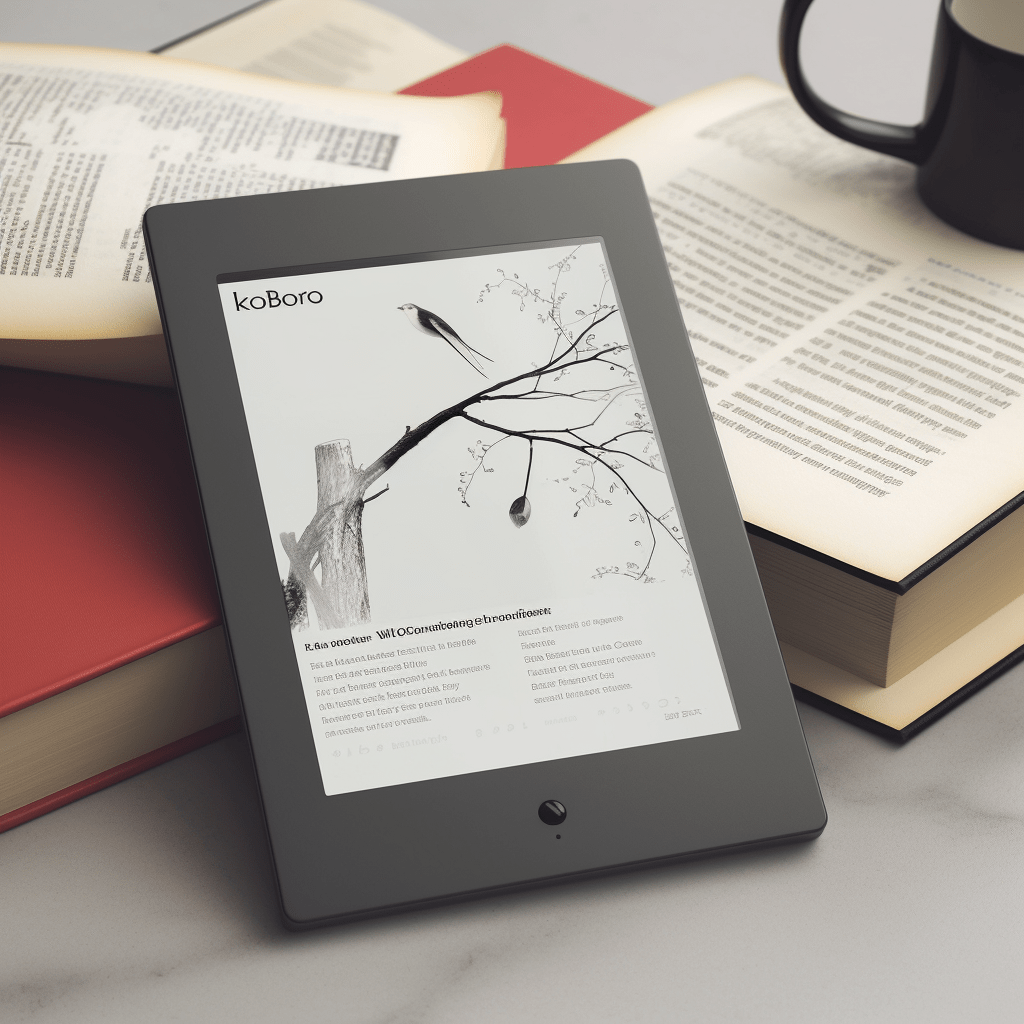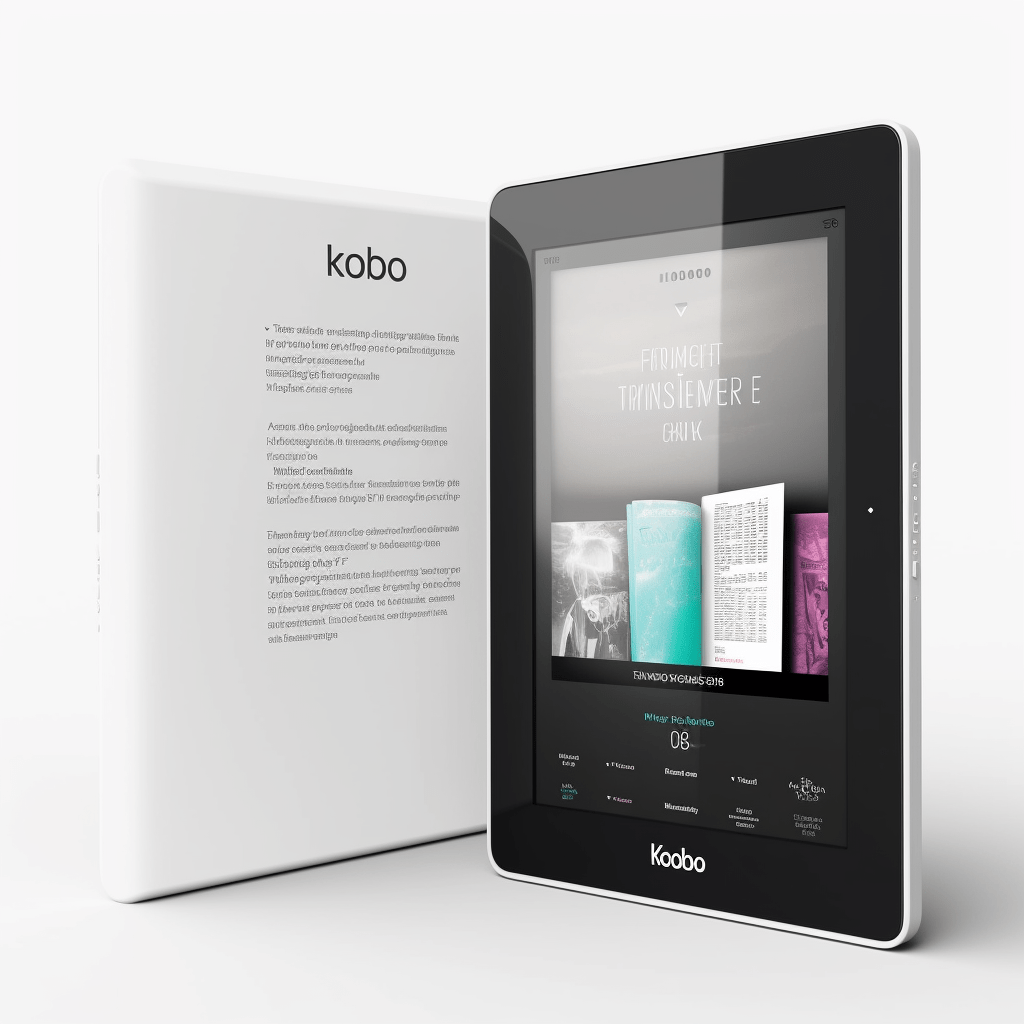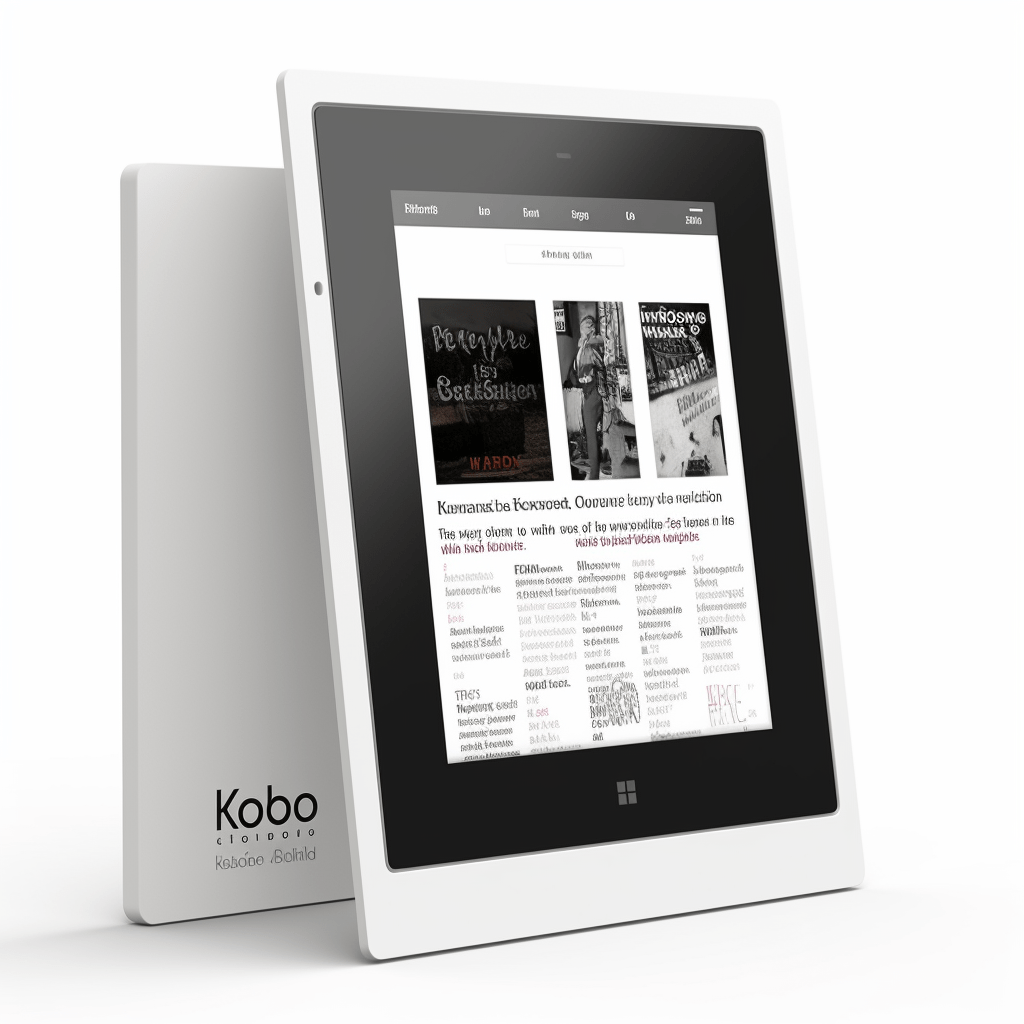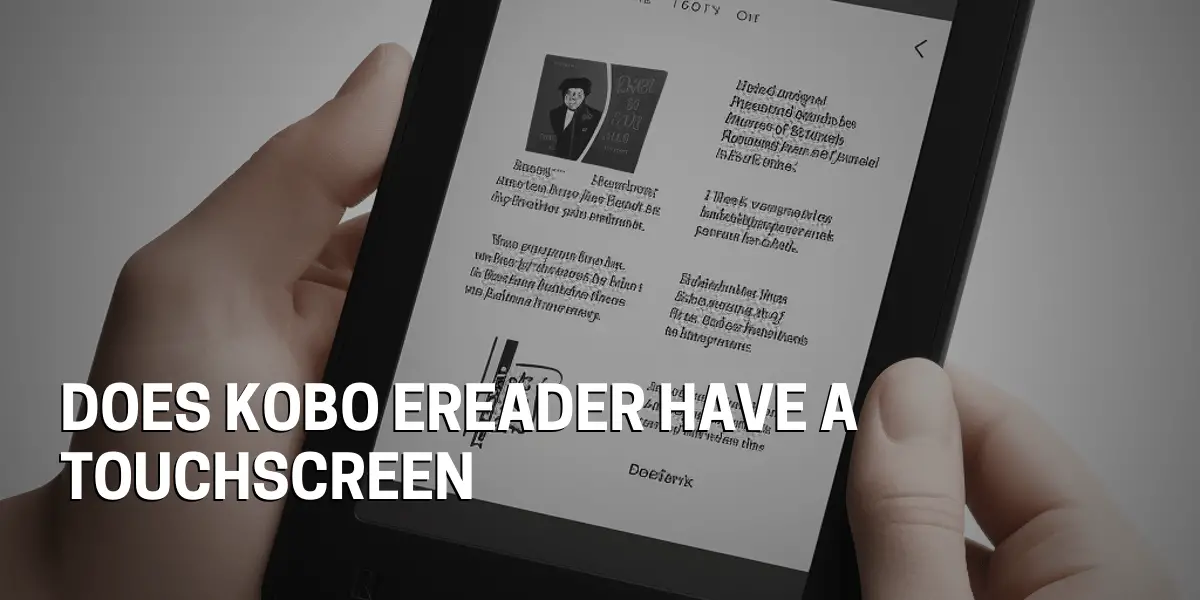Do Kobo Ereaders Have a Touchscreen?
We’ve all heard of the Kobo Ereader, but have you ever wondered if it has a touchscreen? The answer is yes! Kobo Ereaders feature a 6-inch Carta E Ink touchscreen that offers a smooth and responsive experience for users.
With this touchscreen, you can read in bright sunlight without glare, and the front-light allows for reading in low-light conditions.
Additionally, Kobo Ereaders have a side-slider for easy navigation and page turning, as well as buttons for an alternate navigation option.

Types of Kobo Ereaders
How savvy are you when it comes to selecting an e-reader? With so many different models on the market, it can be difficult to decide which one is right for you. Fortunately, the Kobo Ereader range offers a variety of options to suit everyone’s needs.
From the Kobo Clara HD to the Kobo Nia, the range features adjustable font sizes, built-in Wi-Fi, and access to over 6 million ebooks. What’s more, Kobo Ereaders provide displays ranging from 6″ to 8″ with resolutions from 212 PPI to 300 PPI.
No matter which model you choose, you can rest assured it will be compatible with a variety of devices, such as Android and iOS phones, tablets, and computers. Plus, Kobo Ereaders have different storage capacities from 4GB to 32GB and offer up to two months of battery life on a single charge.
And when it comes to navigation, Kobo Ereaders feature a touchscreen for easy page turning, while the side-slider gives you another option.
Features of Kobo Ereaders
Whether for leisure or educational purposes, these lightweight and convenient devices are a great way to enjoy a wide range of books and other content. For those looking for a quality e-reader, the Kobo Ereader range has something for everyone.
Equipped with a 6 inch Carta E Ink touchscreen display, Kobo Ereaders come with 4 GB of internal storage, or up to 30,000 ebooks. In addition, they feature adjustable front light and a battery that can last up to two months on a single charge.
Connectivity wise, these readers offer Wi-Fi connectivity and access to the Kobo Store, where you can purchase and download eBooks. The Kobo Ereader range is also compatible with ePub and PDF files, as well as audiobooks from leading providers such as Audible, Kobo Audiobooks, and more.
We’ll now turn our attention to the display of the Kobo Ereader range to see what sets it apart from the competition.
Display
With a 6-inch Carta E Ink touchscreen display and a resolution of 1024 x 768 pixels, Kobo Ereaders provide a crisp and clear display. The low-glare finish reduces any reflections from the screen, while the touchscreen is very responsive, allowing users to quickly and easily navigate the Ereader.
ComfortLight PRO, a backlight feature, adjusts to match the lighting conditions of the environment, ensuring optimal viewing no matter the hour. The display is designed for long-lasting performance, with a battery life of up to 8 weeks.
Storage
Kobo eReaders are designed with the user in mind, offering a range of storage options and features to suit their needs. With the option of 4GB to 32GB of internal storage, users have plenty of room to store and access their library of eBooks and documents.
Additionally, users can expand the storage capacity with microSD cards up to 32GB, allowing them to store up to 6,000 eBooks or a variety of other documents. Furthermore, Kobo eReaders give users the ability to save bookmarks, notes and highlights on their device.
This makes Kobo eReaders an ideal choice for those seeking a versatile and functional e-reader. Moreover, users can share books and documents with other Kobo users, enabling them to access a vast library of materials.

Connectivity
With Wi-Fi connectivity and support for 802.11b/g/n standards, Bluetooth 4.1, a micro USB port for charging and data connection, users can easily access the content they need. Its e-ink display offers improved readability, while its long-lasting battery life is up to two months. A microSD card slot allows for expandable memory, making the device versatile and perfect for anyone looking for a reliable e-reader.
Battery
The Kobo Ereader is a great choice for anyone looking for an e-reader with a long-lasting battery. To answer this question, it is important to consider the charging time, battery life, power saving mode, rechargeable battery, battery capacity, and replacement of the battery.
Why the Kobo Ereader is equipped with a long-lasting battery is due to its quick charging time. It takes only 2.5 hours to fully charge the battery. Once the battery is fully charged, it will last up to two months on a single charge, or around 30 hours of continuous reading.
The Kobo Ereader also has a power saving mode that allows the user to save battery life and extend the battery life for up to 3 weeks. Additionally, the battery is rechargeable, meaning that it can be used multiple times.
The battery capacity is 2000 mAh, which is larger than most other e-readers in the market. Finally, it is possible to replace the battery in the Kobo Ereader.
All in all, the Kobo Ereader is an excellent choice for anyone looking for an e-reader with a long-lasting battery. With its quick charging time, long battery life, power saving mode, and rechargeable battery, the Kobo Ereader is an ideal device for any reader.
Kobo Ereader Touchscreen Technology
The Kobo Ereader touchscreen technology is a type of capacitive touchscreen, which can detect the presence of a finger or stylus on the display. This type of touchscreen technology is highly sensitive and can detect even the slightest pressure, making it a great choice for those looking for a more accurate and responsive touchscreen experience.
How the Kobo Ereader touchscreen technology works is by utilizing an array of sensors and transistors located underneath the display. When a finger or stylus is placed on the display, it creates an electrical field which is then detected by the sensors. This electrical field is then converted into an action, such as scrolling or selecting items.
There are several advantages to using the Kobo Ereader touchscreen technology. For one, it is highly responsive and accurate, allowing for a smooth and enjoyable user experience. Additionally, it is more energy efficient than other touchscreen technologies, as it uses less power and is more power efficient. Finally, the Kobo Ereader touchscreen technology is extremely durable, making it a great option for those looking for a long-lasting and reliable touchscreen experience.
Despite the many advantages of the Kobo Ereader touchscreen technology, there are a few disadvantages to consider as well. For one, the touchscreen can be difficult to read in bright sunlight or in dim lighting conditions. Additionally, the touchscreen technology can be sensitive to dust and debris, which can cause the touchscreen to malfunction.
There are several different types of Kobo Ereader touchscreen technology, including capacitive, resistive, and optical. Capacitive touchscreen technology is the most popular type used on the Kobo Ereader, as it is highly sensitive and accurate. Resistive touchscreen technology is less accurate and is often used in industrial and medical applications. Finally, optical touchscreen technology is the least accurate and is generally used in gaming and educational applications.
The most popular Kobo Ereader touchscreen types are the capacitive and resistive touchscreen technologies. These two types of touchscreen technologies are the most popular due to their accuracy, responsiveness, and durability. Additionally, they are also the most affordable and can be found in many different sizes and shapes.
Replacing the Kobo Ereader touchscreen technology is also an option, although it is not recommended unless absolutely necessary. This is because replacing the touchscreen can be quite expensive and time consuming, and it is not always possible to find a compatible replacement. Additionally, the touchscreen can be damaged if not installed properly, so it is important to take extra caution when replacing the touchscreen.
In conclusion, the Kobo Ereader touchscreen technology is a great option for those looking for a long-lasting and reliable touchscreen experience. With its high sensitivity, accuracy, and durability, the Kobo Ereader touchscreen technology is an excellent choice for any reader.
Capacitive Touchscreens
Capacitive touchscreens are highly sensitive and accurate, providing a smooth and enjoyable user experience. They are made up of an array of sensors and transistors underneath the display, which detect the electrical field created when a finger or stylus is placed on the screen. This allows the user to scroll, select items, and navigate with ease.
The advantages of using a capacitive touchscreen are numerous. They are highly responsive and accurate, providing a seamless user experience. Additionally, they are energy efficient, using less power than other touchscreen technologies. Furthermore, capacitive touchscreens are also extremely durable, making them a great choice for those looking for a long-lasting and reliable touchscreen experience.
On the flip side, there are a few drawbacks to consider when it comes to capacitive touchscreens. For one, they can be difficult to read in bright sunlight or dim lighting conditions. Additionally, they can be sensitive to dust and debris, which can cause the touchscreen to malfunction.
When it comes to devices that use capacitive touchscreens, Kobo Ereaders are one of the most popular choices. The Kobo Ereader touchscreen technology is highly sensitive and accurate, providing a smooth and enjoyable user experience. Additionally, it is more energy efficient than other touchscreen technologies, as it uses less power and is more power efficient. Finally, the Kobo Ereader touchscreen technology is extremely durable.
Do Kobo Ereaders have a capacitive touchscreen? The answer is yes. This type of touchscreen technology is highly sensitive and accurate, making it a great choice for those looking for a more accurate and responsive touchscreen experience.
When it comes to alternatives to capacitive touchscreens for ereaders, there are a few different options available. These include resistive touchscreen technology, which is less accurate and often used in industrial and medical applications; optical touchscreen technology, which is the least accurate and is generally used in gaming and educational applications; and finally, replacing the touchscreen, which is not recommended unless absolutely necessary.
Overall, capacitive touchscreens are a great option for those looking for a long-lasting and reliable touchscreen experience. They offer a seamless user experience, are energy efficient, and are highly durable.

Resistive Touchscreens
When it comes to touchscreen technology, one of the most popular choices is the resistive touchscreen. This type of touchscreen is used in many devices, including Kobo Ereaders. Resistive touchscreens work by registering finger pressure, which then causes a physical connection between two layers of the touchscreen. Compared to other touchscreen technologies, such as capacitive touchscreens, this type of touchscreen is less sensitive. However, resistive touchscreens are more reliable and cost-effective than their capacitive counterparts. The Kobo Ereader uses a resistive touchscreen, meaning it requires pressure to register a touch.
But what are the advantages and disadvantages of using a resistive touchscreen? On the plus side, resistive touchscreens are more reliable than capacitive touchscreens, as they are not affected by dirt and dust. Additionally, they are also more cost-effective than their capacitive counterparts. However, resistive touchscreens are not as accurate as capacitive touchscreens, and they are less responsive to human touch.
Overall, resistive touchscreens offer a reliable and cost-effective touchscreen experience. They are more reliable than capacitive touchscreens, as they are not affected by dirt and dust. Additionally, they are more cost-effective than their capacitive counterparts.
Pros and Cons of Kobo Touchscreens
Kobo Ereaders are popular reading devices, but many people are wondering if they have a touchscreen. The answer is yes, Kobo Ereaders do have a touchscreen. But why would someone choose a touchscreen over a traditional ereader?
One of the main advantages of a touchscreen on a Kobo Ereader is that it provides a more intuitive user experience, as users can navigate and interact with the device more naturally. Additionally, a touchscreen can also provide a more immersive reading experience, because users can use gestures such as swiping, pinching and zooming to get a better look at the text they are reading.
However, there are also some drawbacks to consider. Touchscreens can be more sensitive and prone to accidental touches, which can lead to users inadvertently opening apps or making unwanted changes. They can also be prone to finger smudges, which can reduce visibility and detract from the overall reading experience. Furthermore, touchscreen technology is more expensive than traditional ereaders.
Overall, touchscreens can provide a more intuitive user experience and a more immersive reading experience, but they can also be more susceptible to accidental touches and finger smudges as well as being more expensive. When considering whether or not to get a Kobo Ereader with a touchscreen, it is important to weigh the pros and cons carefully.
Examples of Kobo Ereader Touchscreens
The Kobo Ereader is a popular reading device among avid readers, but one of its unique features is the touchscreen. Kobo Ereaders come with a variety of touchscreen sizes, ranging from 6-inch E Ink Carta displays to 8-inch displays. The Kobo Clara HD, Kobo Aura H2O Edition 2, Kobo Aura Edition 2, Kobo Forma, Kobo Libra H2O, Kobo Nia, Kobo Touch 2.0, Kobo Glo HD, and Kobo Aura One all have a touchscreen, though the sizes vary.
The touchscreen provides a more intuitive user experience and a more immersive reading experience, allowing users to navigate and interact with the device in a natural way.
However, touchscreens can also be more sensitive and prone to accidental touches, as well as leaving visible finger smudges. They are also more expensive than traditional ereaders.
Therefore, it is important to consider the pros and cons of Kobo touchscreens before purchasing one.
Summary
We all know that Kobo Ereaders are popular reading devices among avid readers, but one of its most distinguishing features is the touchscreen. Kobo Ereaders come in various sizes and models, all of which have a touchscreen. The touchscreen allows users to interact with their device and access different features with ease.
It also offers a more intuitive experience for readers, making it easier to navigate the device. The touchscreen is highly responsive and users can interact with their device without any lag. However, the touchscreen can also be more sensitive and prone to accidental touches, as well as leaving visible finger smudges.
Additionally, it is more expensive than traditional ereaders. Therefore, it is important to consider the pros and cons of Kobo touchscreens before purchasing one.
FAQs
What types of Kobo Ereaders are available?
Kobo currently offers a range of ereader models, including the Clara HD, Libra H2O, Forma, Aura Edition 2 and the Aura One. Each of these models has a 6-inch touchscreen display that provides a crisp, clear reading experience. Furthermore, the Kobo Libra H2O also features an adjustable ComfortLight PRO, which helps reduce blue-light exposure and make nighttime reading more comfortable.
The Kobo Forma model is waterproof and dustproof, making it ideal for those who read on the go. The Kobo Aura One is the largest Kobo model, with a 7.8-inch touchscreen display and adjustable ComfortLight PRO.
The Clara HD is the most affordable model, featuring a 6-inch touchscreen display and a lightweight design. The variety of models, sizes, and features make Kobo Ereaders a viable option for any reader.
What are the features of Kobo Ereaders?
When it comes to ereaders, Kobo is a leading name in the industry. From the 6-inch touchscreen display to the adjustable ComfortLight PRO, Kobo Ereaders are designed to provide a quality reading experience. With the ability to read a wide range of digital formats, Kobo Ereaders offer readers the flexibility to enjoy their favorite books and magazines. Additionally, the high-resolution displays provide sharper images and clearer text. The built-in lighting ensures that readers can enjoy their content even in low-light conditions. Furthermore, the Kobo Ereaders are equipped with connectivity options that allow readers to download books and other content. Plus, the long-lasting battery life ensures extended reading time. Kobo Ereaders are customizable, with the ability to choose from different fonts and page styles. In this way, Kobo Ereaders provide readers with the right features to make the most of their reading experience.
What type of touchscreen technology does Kobo use?
This question is often asked by readers who are considering purchasing a Kobo Ereader: what type of touchscreen technology does the device use? The answer is that Kobo utilizes an infrared touchscreen technology, which is similar to the one used in smartphones and tablets.
Not only is the touchscreen sensitive to the touch and responds quickly, but it also makes navigating the various features of the device a breeze. The infrared touchscreen is highly accurate and offers a wide range of interactive capabilities, allowing readers to access the device’s features with ease.
Kobo Ereader owners enjoy the convenience of having a touchscreen that can be used to quickly and conveniently access their favorite digital books and magazines. But how does the technology stack up against other devices?
What are the benefits and drawbacks of Kobo touchscreens?
When it comes to Kobo’s Ereaders, many readers are wondering about the benefits and drawbacks of touchscreens. For those considering the purchase of a Kobo, it is important to understand the technology and its potential implications. Why is a touchscreen such an attractive feature? Well, the biggest benefit of using a touchscreen on Kobo’s Ereaders is intuitive navigation, improved accessibility, and the ability to draw and write.
For those who want to use the device for more than simply reading, these features can be incredibly useful. However, like any technology, there are drawbacks. For one, the battery life of a touchscreen-enabled Kobo Ereader can be reduced due to the strain of the touchscreen’s features. Additionally, there is the possibility of accidental input, which can be disruptive if it happens too often.
Furthermore, the touchscreen can be more prone to scratches and smudges, which can affect the clarity of the display. The responsiveness of the touchscreen can vary depending on the quality and sensitivity of the device, and its size may limit the size of the text and images that can be displayed.
Are there any examples of Kobo Ereaders with touchscreens?
When it comes to Kobo ereaders, many readers are curious about the advantages of having a touchscreen. For those considering purchasing a Kobo, it is important to understand the technology and its potential benefits. What makes a touchscreen such an attractive feature? Well, the main advantage of using a touchscreen in Kobo ereaders is the intuitive navigation and improved accessibility. With a few simple taps, users can easily access their favorite books and enjoy an immersive reading experience.
In addition, these devices also feature a 6-inch touchscreen and use Carta E Ink technology, making them comfortable to use while reading. The touchscreens are also highly responsive and fluid, allowing users to navigate the device with ease.
Moreover, the Kobo Ereader touchscreens are glare-free, which is great for those who like to read in bright sunlight or other conditions with strong lighting. Overall, a touchscreen-enabled Kobo Ereader is an excellent choice for those who want to get the most out of their reading experience.
The only potential downside is that the battery life of such a device can be reduced due to the strain of the touchscreen’s features, as well as the possibility of accidental input and the tendency for the touchscreen to be more prone to scratches and smudges. Despite these drawbacks, a touchscreen-enabled Kobo Ereader is a great choice for those who want the convenience and enhanced user experience of a touchscreen.

